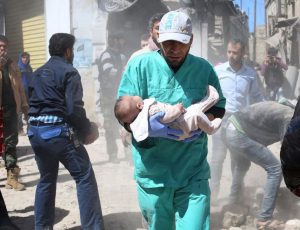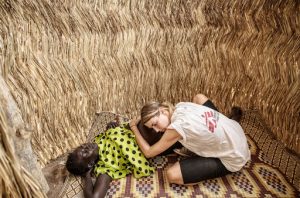REPRODUCTIVE HEALTH IN REFUGEE WOMEN
Refugee women affected by the negative effects of both forced and non-compulsory migration more than men and children. Also they constitute the most important health risk group. As a result of the ev aluation of the reproductive health problems of refugee women and their use of health services, the need for organizing sustainable health promotion programs is increasing.
aluation of the reproductive health problems of refugee women and their use of health services, the need for organizing sustainable health promotion programs is increasing.
Refugee women, especially those in out-of-control camps, do not sufficiently benefit from prenatal care service due to low socioeconomic level, socio-cultural and psychological factors, the rates of hospital births are low, and the rates of births made by non-professionals under unhealthy conditions are high. The belief that giving birth to many children is important for the continuation of the family status, due to the cultural structures and beliefs of refugee women, prevents them from benefiting from family planning services.
The refugee camps which Syrian women live in Turkey, more than 15.000 births took place so far. The risk of delivering a disabled baby and early pregnancy loss is higher than other women because of refugee women have low socioeconomic levels, receive less prenatal care, unhealthy lifestyles, high rates of contagious diseases, exposure to violence, being under intense stress and giving birth in unhealthy conditions.
In the study conducted by the Disaster and Emergency Management Presidency (AFAD) in 2014, it was found that adolescent pregnancies (13-14 years old) were frequently encountered among those who migrated from Syria. Accordingly, for refugee women, health promotion programs should be planned to education and basic needs for 15-49 age follow-ups, to benefit from antenatal care services and to prevent adolescent marriages and adolescent pregnancies.

Reproductive Health Services for Refugee Women and Barriers Affecting Their Use
In a study conducted in Turkey, evaluated views on women’s health of Syrian refugees in Turkey. Refugee women have indicated that they do not use for their own health, they use health services for their children’s health. Furthermore, they were concerned that they would not be treated equally while receiving women’s health care. In addition, they do not want to receive health services due to language problems and economic problems. It has been determined that refugee women benefit less from preventive and therapeutic reproductive health services such as prenatal and postpartum care and vitamin support, vaccination and screening tests and gynecological examinations. This may cause delay in diagnosis of treatable problems and congenital anomalies in babies.
The obstacles identified in the literature in terms of refugee women’s access to healthcare services are as follows:
- Individual barriers such as not knowing the language of the migrated region,
- Low education and socioeconomic level,
- Inability to adapt to cultural differences,
- Insufficient health knowledge,
- Avoidance of male health personnel,
- Limited decision-making power of women;
- Systemic barriers such as difficulties in accessing healthcare institutions,
- Long waiting times in the clinic,
- Lack of health insurance,
- Lack of sufficient health institutions and qualified personnel in the regions of immigration,
- Traditional lifestyle,
- Insufficient social support,
- Legal limitations,
- Insensitivity to the culture of healthcare services,
- Knowledge and experience of healthcare professionals and lack of interpreters.
Solution Proposals for Refugee Women to Access Reproductive Health Services

According to the World Health Organization (WHO) recommendations; Refugees and migrants should have full and uninterrupted access to quality healthcare, regardless of gender, age, religion, nationality, or race. WHO supports policies for health services to be provided regardless of the legal status of immigrants. In line with these policies, suggestions for finding permanent solutions to the problems experienced by refugee women in accessing reproductive health services are given below:
- Accepting refugee women as a priority and special group by healthcare professionals, informing them to protect and improve their health,
- Knowing the problems of refugee women by healthcare personnel, directing them to appropriate resources,
- Training healthcare personnel for a care free from prejudices,
- Healthcare personnel should respect the privacy of refugee women and provide care sensitive to cultural differences,
- Providing services and counseling in terms of protection from pregnancy and sexually transmitted infections, and managing problems related to abortion and childbirth,
- Identifying harmful traditional practices (vaginal douching, genital mutilation, etc.) and providing training and consultancy to reduce these practices,
- Especially at birth, providing the support of the birth coach with the same culture and language rather than an interpreter,
- Providing psychological counseling services to all women, especially victims of violence and abuse,
- Planning and executing projects for the immigrant friendly hospital application,
- Creating social awareness through the media in terms of solving the problems of refugee women in accessing reproductive health services,
- Identifying refugee women outside of camps and shelters, making legal arrangements and planning projects to support the creation of health policies so that they can access reproductive health services,
- To make regular pregnancy follow-ups to inform women in order to reduce home births, to make arrangements regarding health insurance or health service fees,
- In order to prevent sexual abuse due to adolescent marriages and pregnancies, government agencies make camp and home visits,
- Conducting studies to prevent adolescent pregnancies, reviewing / increasing the penal sanctions against the responsible persons and giving importance to the education of adolescents,
- Giving importance to the training of qualified (knowledgeable about health, good interpersonal communication and ethical behavior) interpreter,
- To increase the quality of health services by increasing the accessibility of health services.
REFERANCES
Arabacı, Z., Hasgül, E., & Serpen, A.S. (2016). Migrant women and migration’s effect on women’s health in Turkey. Sosyal Politika Çalışmaları Dergisi, (36), 129-144.
Artelt, T., Kaase, M., & Scheithauer, S. (2017). Challenges regarding ınfectious diseases in migrants. Der Gynäkologe, 50 (2), 134–138.
Balic, D., Rizvanovic, M., Sajko, M.C., & Balic, A. (2014). Age at natural menopause in refugee and domicile women who lived in Tuzla Canton in Bosnia and Herzegovina during and after the war. Menopause: The Journal of The North American Menopause Society, 21 (7), 721-725.
Baş, D., Arkant, C., Muqat, A., Arafa, M., Sipahi, T.,& Eskiocak, M. (2015). Edirne’deki Suriyeli sığınmacıların durumu. 18. Ulusal Halk Sağlığı Kongresi (Kongre Kitabı). Konya. 5-9 Ekim, 214-215.
Başbakanlık Afet ve Acil Durum Yönetimi Başkanlığı (AFAD). (2014). Türkiye’deki Suriyeli kadınlar. Erişim: 18.03.2017. https://www.afad.gov.tr/Dokuman/TR/80
Bilican, G.V., & Ayan, S. (2016). İç göç ve kentleşme sürecinde kadının ekonomik yoksunluğu. Journal of International Social Research, (9) 46, 390-398.
Büyüktiryaki, M., Canpolat, E., Dizdar, E.A., Okur, N., & Şimşek, G.K. (2015). Neonatal outcomes of Syrian refugees delivered in a tertiary hospital in Ankara, Turkey. Conflict and Health, 9, 38-49.
Çakmak, S. (2010). Değişen hayatların görünmez sahipleri: Göçmen kadınlar. Feminist Eleştiri Dergisi, 2, 50-64. Erişim: 18.03.2017. http://cins.ankara.edu.tr/goc3.html
Çaman, K.Ö., & Özvarış, Ş.B. (2010). Uluslararası göç ve kadın sağlığı. Sağlık ve Toplum, 20 (4), 3-13.
Çelik, N., & Sevil, Ü. (2016). Migration and women. Türkiye Klinikleri Journal of Obstetric Women’s Health and Diseases Nursing, 2 (2), 74-90.
Demir, G., & Arıöz, A. (2014). Göç eden kadınların sağlıklı yaşam biçimi davranışları ve etkileyen faktörler. Düzce Üniversitesi Sağlık Bilimleri Enstitüsü Dergisi, 4 (2), 1-8.
Dias, S., Gama, A., Cargaleiro, H., & Martins, M.O. (2012). Health workers’ attitudes toward ımmigrant patients: A cross-sectional survey in primary health care services. Human Resources for Health, 10: 14, 1-6.
Düşünder, T.A., & Çilingir, S.Y. (2017). Göçmenlere karşı kötümserlik artıyor mu? Türkiye Ekonomi Politikaları Araştırma Vakfı. Erişim: 02.04.2017. http://www.tepav.org.tr/upload/files/14845693013.Gocmenlere_Karsi_Kotumserlik_Artiyor_Mu.pdf
Doğanay, H., Şahin, F., & Özdemir, Ö. (2007). Feminist coğrafya ve kadın göçmenler. Doğu Coğrafya Dergisi, 12 (17), 7-16.
Gümüş, G., Kaya, A., Yılmaz, S.G., Özdemir, S., Başıbüyük, M., & Coşkun A.M. (2017). Suriyeli mülteci kadınların üreme sağlığı sorunları. Kadın Sağlığı Hemşireliği Dergisi, 3 (1), 1-17.
Hannoun, A.B., Nassar, A.H., Usta, I.M., & Musa, A.M. (2007). Effect of war on the menstrual cycle. Obstetrics and Gynecology, 109 (4), 929-32.
International Rescue Committee (IRC). (2015). The refugee crisis in Europe and the Middle East. Erişim: 03.02.2017. https://www.rescue.org/sites/default/files/documen
Islam, M.M., & Gagnon, A.J. (2016). Use of reproductive health care services among urban migrant women in Bangladesh. BMC Women’s Health, 16, 15.
İnsan Hakları ve Mazlumlar İçin Dayanışma Derneği (MAZLUMDER). (2014). Kamp dışında yaşayan Suriyeli kadın sığınmacılar raporu. Erişim: 01.02.2017. http://panel.stgm.org.tr/vera/app/var/files/m/a/mazlumder-kamp-disinda-yasayan-suriyeli-kadin-siginmacilar-raporu.pdf
Kadın Merkezi Vakfı (KAMER). Sığınmacı kadınlar- beş il raporu. Erişim: 01.02.2017. http://www.kamer.org.tr/menuis/kamer_vakfi_siginmaci_kadinlar_5_il_raporu.pdf
Kaypak, Ş., & Bimay, M. (2016). Suriye savaşı nedeniyle yaşanan göçün ekonomik ve sosyo-kültürel etkileri: Batman örneği. Batman Üniversitesi Batman Yaşam Bilimleri Dergisi, 6 (1).
Keklik, Z.A., & Koruk, İ. (2017). Suriyeli sığınmacılarda hepatit B ve C seroprevalansı ile bu hastalıklarla ilgili bilgi, tutum ve riskli davranış düzeyleri. 19. Ulusal Halk Sağlığı Kongresi (Kongre Kitabı). Antalya. 15-19 Mart, 184.
Krause, S., Williams, H., Onyango, M.A., Sami, S., Doedens, W., Giga, N. et al. (2015). Reproductive health services for Syrian refugees in Zaatri camp and Irbid city, Hashemite Kingdom of Jordan: An evaluation of the minimum initial services package. Conflict and Health, 9 (1), 4.
Liu, Z.Y., Li, J., Hong, Y., & Yao, L. (2016). Reproductive health service utilization and social determinants among married female rural-to-urban migrants in two metropolises, China. Journal of Huazhong University of Science and Technology Medical Sciences, 36 (6), 904-909.
Mccann, P., Poot, J., & Sanderson, L. (2010). Migration, relationship capital and ınternational travel: Theory and evidence. Journal of Economic Geography, 10 (2), 361-87.
Mejía, O.L., & Christopher, J.M. (2010). Acculturative stress, depression, and anxiety in migrant farmwork college students of Mexican heritage. International Journal of Stress Management, 17 (1), 1-20.
Missal, B., Clark, C., & Kovaleva M. (2016). Somali ımmigrant new mothers’childbirth experiences in minnesota. Journal of Transcultural Nursing, 27, 359–367.
Oğuz, S., Tuygun, N., Polat, E., Akça, H., & Karacan C.D. (2016). Savaş ve çocuk: Suriye iç savaşının sınırdan 750 km uzaktaki bir çocuk acil servisine etkisi. Çocuk Acil ve Yoğun Bakım Dergisi, 3, 135-139.
Orhan, O., & Gündoğar, S.S. (2015). Suriyeli sığınmacıların Türkiye’ye etkileri. Ortadoğu Stratejik Araştırmalar Merkezi (ORSAM). Erişim: 10.04.2017. http://tesev.org.tr/wp-content/uploads/2015/11/Suriyeli_Siginmacilarin_Turkiyeye_Etkileri.pdf
DEUHFED 2018, 11 (1), 56-60 Mülteci Kadınların Üreme Sağlığı 60
Dokuz Eylül Üniversitesi Hemşirelik Fakültesi Elektronik Dergisi http://www.deuhyoedergi.org
Önal, A., & Keklik, B. (2016). Mülteci ve sığınmacıların sağlık hizmetlerine erişimde yaşadığı sorunlar: Isparta ilinde bir uygulama. Süleyman Demirel Üniversitesi Vizyoner Dergisi, 7 (15), 132-148.
Rogers, C., & Earnest, J. (2014). A cross-generational study of contraception and reproductive health among sudanese and eritrean women in brisbane. Australia Health Care for Women International, 35, 334–356.
Salisbury, P., Hall, L., Kulkus, S., Paw, M.K., Tun, N.W., Min A.M. et al. (2016). Family planning knowledge, attitudes and practices in refugee and migrant pregnant and post-partum women on the thailand- myanmar border – a mixed methods study. Reproductive Health, 13, 94.
Schmid, A.P. (2016). Links between terrorism and migration. International Centre For Counter Terrorism (ICCT), ICCT Research Paper.
Şenol, D., & Dinç, A. (2016). Türkiye’nin Suriyeli çocuk gelinleri: sosyolojik bir değerlendirme. Üsküdar Üniversitesi Suriyeli Çocuklarla El Ele Uluslararası Göç ve Çocuk Sempozyumu. İstanbul. 17-18 Kasım.
Şimşek, Z., Doğan, F., Hilali, N.G., & Özek, B. (2015). Bir il merkezinde yaşayan 15-49 yaş evli Suriyeli kadınlarda üreme sağlığı göstergeleri ve hizmet ihtiyacı. 18. Ulusal Halk Sağlığı Kongresi (Kongre Kitabı). Konya. 5-9 Ekim, 998-999.
Topçu, S., & Beşer, A.(2011). Health promoting life-styles among immigrant and nonimmigrant women. Dokuz Eylül Üniversitesi Hemşirelik Fakültesi Elektronik Dergisi, 4 (2), 56-62.
Türk Tabipleri Birliği Yayınları (TTB) Ankara. (2016). Savaş, göç ve sağlık. Erişim: 18.03.2017. https://www.ttb.org.tr/kutuphane/siginmacilar_rpr.pdf
United Nations High Commissioner for Refugees (UNHCR) – Women. Erişim: 18.03.2017. http://www.unhcr.org/women.html
United Nations Population Fund (UNFPA). (2016). Women and girls in the Syria crisis: UNFPA response facts and figures. Erişim: 18.03.2017. htttps://www.unfpa.org/sites
Türk Tabipleri Birliği Yayınları (TTB). Göç ve sağlıkla ilgili sıkça sorulan sorular. Erişim 03.03.2017. www.ttb.org.tr/goc/dsogocvesaglik.docx
Yıldırımkaya, G. (2014). Mülteciler ve üreme sağlığı riskleri. Türkiye Aile Sağlığı ve Planlaması Vakfı. Görünüm. Ocak, 1-5.
Yıldız, B.İ., & Cengiz, P. (2016). Savaşın kadınlar üzerindeki etkisi: Bosna & Suriye. Erişim: 03.02.2017. http://myweb.sabanciuniv.edu/bac/files/2013/10/
Yılmaz, A. (2014). Uluslararası göç: çeşitleri, nedenleri ve etkileri. International Periodical For the Languages, Literature and History of Turkish or Turkic, 9 (2).

